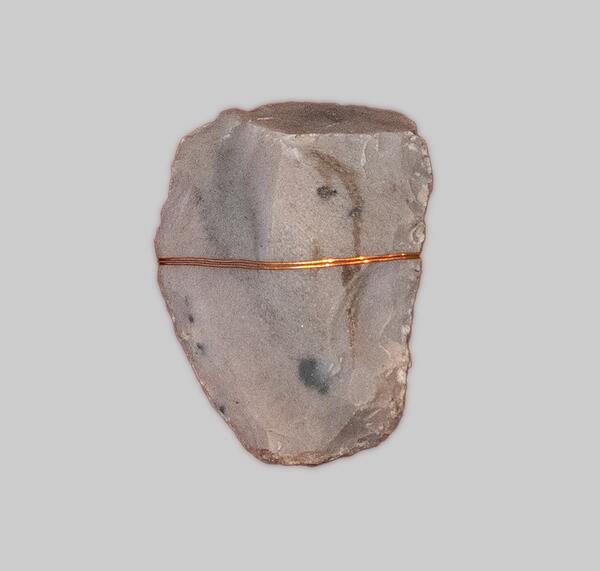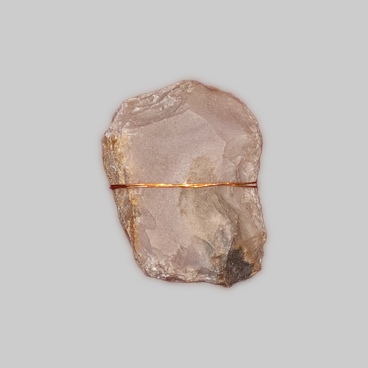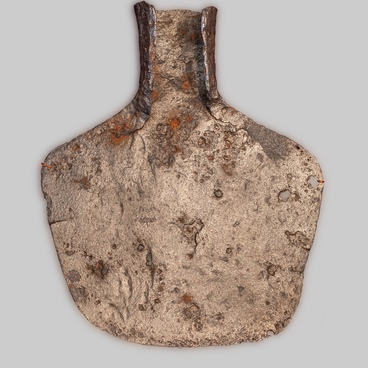An obvious advantage of the Russian service class people over the nomads was the availability of fire weapons. There exited several types of hand fire weapons: ‘smooth-bore’ arquebuses, rifles, muskets, trigger-based handguns. Rifles had smaller weight and larger range of firer. All firearms were flintlock. No complete samples are available in Kuznetsk, only their elements.
Flint was a component of the gun’s lock. Arquebuse flint in the museum collection was found in the excavation of a house in Kuznetsk ostrOg of XVII century. It is a radially, i.e., symmetrically processed stone, a grey-rose quarzrock retouched along the outline.
A flint gun is a smooth- or rifle-bore hand weapons with a flint lock. A detonating flintlock invented early in XVII century combined the advantages of various designs of spark locks. The flint lock was relatively simple, very efficient, and it was widely used both in pistols and guns.
The birthplace of the flint lock is France, but by mid- XVII century it became widely spread in most European countries. It was so popular that it remained in use for over 200 years, and it continued to be manufactured until 1830-s.
The flint guns were preceded by an earlier spark detonating lock. In the first samples the flint and the flash pan cover were an integral whole. Part of the trigger and firing mechanism, a sear, moved vertically to fit two cut-offs in the notch tumbler – a disc attached to the same axe with the firing hammer. Those cut-offs allowed putting the hammer in full- or half-cock position. Half-cock position of the hammer was safe. Before shooting, the hammer was put into full-cock position, and then the trigger was pulled. The flint struck against the stone simultaneously opening the flash pan cover and striking the sparks that went to the priming powder. The priming powder ignited and set the propellant powder on fire, located in the bore together with a round bullet.
After the flint locks spread over Western Europe in the 1630-s, national specifics started to be manifested. Each workshop developed its own easily recognizable style. The principal European firearms supplier early in XVII century was France — flint pistols manufactured by Paris gun makers are part of the best European collections.
Flint was a component of the gun’s lock. Arquebuse flint in the museum collection was found in the excavation of a house in Kuznetsk ostrOg of XVII century. It is a radially, i.e., symmetrically processed stone, a grey-rose quarzrock retouched along the outline.
A flint gun is a smooth- or rifle-bore hand weapons with a flint lock. A detonating flintlock invented early in XVII century combined the advantages of various designs of spark locks. The flint lock was relatively simple, very efficient, and it was widely used both in pistols and guns.
The birthplace of the flint lock is France, but by mid- XVII century it became widely spread in most European countries. It was so popular that it remained in use for over 200 years, and it continued to be manufactured until 1830-s.
The flint guns were preceded by an earlier spark detonating lock. In the first samples the flint and the flash pan cover were an integral whole. Part of the trigger and firing mechanism, a sear, moved vertically to fit two cut-offs in the notch tumbler – a disc attached to the same axe with the firing hammer. Those cut-offs allowed putting the hammer in full- or half-cock position. Half-cock position of the hammer was safe. Before shooting, the hammer was put into full-cock position, and then the trigger was pulled. The flint struck against the stone simultaneously opening the flash pan cover and striking the sparks that went to the priming powder. The priming powder ignited and set the propellant powder on fire, located in the bore together with a round bullet.
After the flint locks spread over Western Europe in the 1630-s, national specifics started to be manifested. Each workshop developed its own easily recognizable style. The principal European firearms supplier early in XVII century was France — flint pistols manufactured by Paris gun makers are part of the best European collections.



